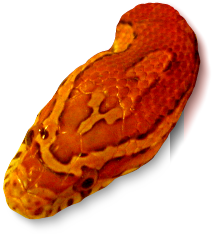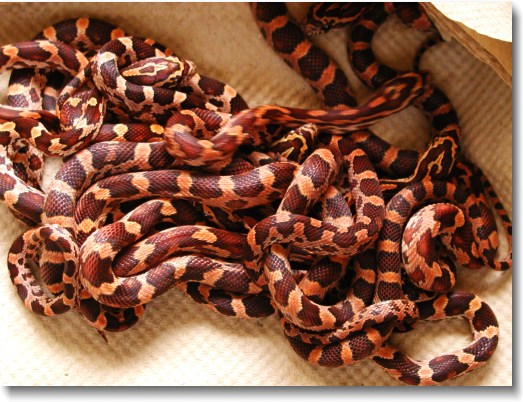Corn Snake
pictures and facts

Reproduction
Corn snakes usually breed in the spring from April to June. [35] Brumation (a light version of hibernation [36] ) is not required, but usually best breeding occurs after a brumation of 3 months at 55°F (12.8°C). [37] Corn snakes are oviparous, which means the embryos develop in the egg outside of the mother's womb. [38] During the first part of summer, females lay 3 to 40 eggs in rotting stumps, piles of decaying vegetation, or other locations where there is sufficient heat and humidity to incubate the eggs. Newborns hatch in 2 to 3 months, from July to September. [39]Juvenile Corn Snakes
Young hatchling corn snakes range from 8 to 14 in. (20.3 to 35.6 cm) in length when they hatch, so they will predominantly feed on lizards (particularly Anolis sp.), and small frogs, as these are small enough for them to catch and eat. [40] [41] Hatchlings will also eat nesting rodents, if they can find them. [42] The coloring of hatchling corn snakes is similar to adults but duller in coloration and brightness. [43] [44] Juvenile corn snakes are especially susceptible to predators such as birds, raccoons, skunks, and other predators. [45] Only a few from each clutch will usually survive to adulthood. [46]
Baby corn snakes.
Image Source: Photo taken by Corn Snake Pictures & Facts at the San Bernardino County Museum, with permission.
Available in two sizes:
1024 x 768 || 800 x 600
Captive Corn Snakes
Their beautiful coloration, hardiness in a wide variety of environments, and docile temperament in captivity easily explain why corn snakes are one of the most popular species of pet snake sold today. [47] [48] In captivity, with proper care, corn snakes can live between 15 to 20 years. In the wild they live considerably less. [49]Handling
Corn snakes are "handling pets." They can be held often and do not get stressed out by constant handling. In fact they seem to enjoy it. [50] Although a corn snake is a constrictor, unlike Python's or King snakes they will not wrap themselves snugly around your arms. Instead they tend to want to move. Although they are quite strong, always support the body and give the head freedom to move. Corn snakes have a docile temperament, but can become nervous when introduced to new situations with new people. It is a good idea to give snakes a few days to become familiar with new people before being handled. If the snake starts moving in a direction you don't want it to, gently guide it by the head into another. [51]Selecting a Snake
A healthy corn snake should have a well fleshed out body with no visible cuts or abrasions. Its eyes should be clear and alert, the tongue flicking. One caveat here is that if a corn snake is about to shed its skin, its eyes will turn a milky blue. Look for signs of mites or ticks. [52] Mites will appear as small fast moving red, black, or white dots on the surface of the skin. Ticks are larger, usually fewer in number, and remain attached to one place, usually between or under the scales. [53] Also look for any discharge such as stringy mucus coming out of the nose or mouth, as these are signals of disease or infection. [54]